By Franco Palamaro and Paolo Ortenzi
Transition from a full power caliber round – 7.62x51mm NATO – to the smaller 5.56x45mm intermediate caliber, as the standard cartridge for Italy’s Armed Forces, has been time consuming and troublesome, generating a technological gap between Italy and other nations, both NATO and Warsaw Pact. All this may have changed with Beretta’s new creation: the ARX 160.
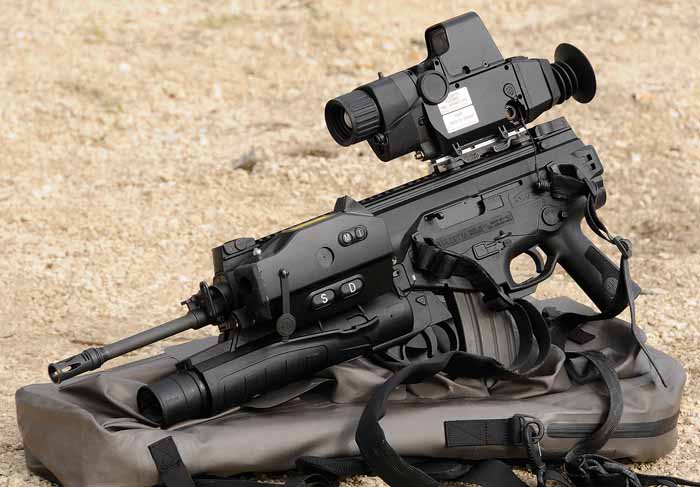
The authors were invited to attend the presentation ceremony of the new Beretta ARX 160 Assault Rifle from the world’s oldest firearm manufacturer still in business and test fire the weapon on an Italian Army firing range located in Nettuno, a city facing the Mediterranean Sea, roughly 35 miles south of Rome. This location is well known in America for being, together with Anzio, the beachhead and battle site for the Allied Forces landing of Operation Shingle in World War II.
The ARX 160 is currently delivered in a hard case containing all accessories. A special waterproof and floating soft bag is also available for maritime operations. It is a gas operated, select-fire assault rifle, with a piston action located above the barrel, which fires from a closed bolt.
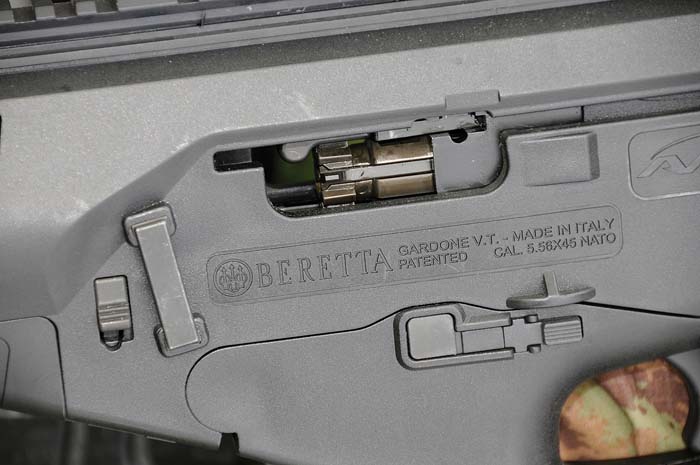
The weapon’s design is streamlined and stylish, with a dark, flat grey colored Polymer body and is totally different from the sharp and edgy lines of the well known AR70/90. It loosely resembles the lines of the FN SCAR, especially in the stock design, but the rifle is lighter, more compact and structurally very different.
We tested the final version of the weapon that was assembled in a small scale production line that will be ramped up for full scale production in a few months. This version was preceded by a long series of prototypes, built patiently pursuing the best results and performance, taking seriously in account vital feedback from military beta testers, including operators in actual combat scenarios.
The ARX 160 has been engineered from the start to be extremely flexible and modular so as to tailor its individual performance for the mission or task at hand. There are two barrel lengths available at this time for the weapon: 16-inch (standard) and 12-inch (defined, by Beretta, “for special operations”). A 20-inch barrel has been tested, and a 16-inch HB with Match grade rifling should be available shortly to fill in a DMR role.
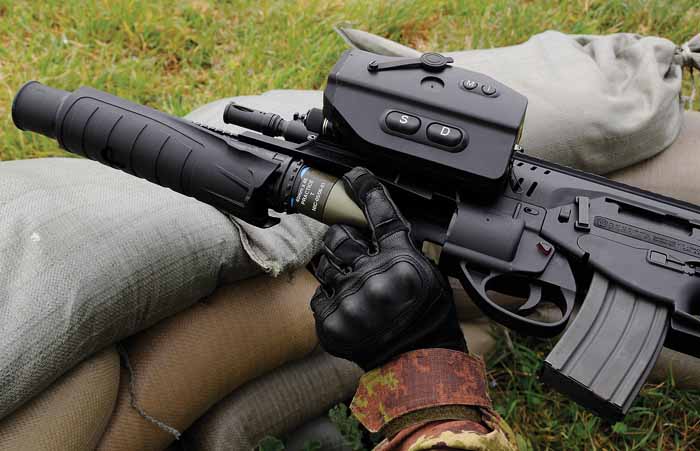
Both the 16-inch and 12-inch barrels have a flash hider/compensator fitted with 5 radial cuts, plus other 4 smaller cuts, indexed so as to aid in controlling muzzle climb when shooting full auto. Barrels are chrome lined and have a 1:7 twist, optimized for the SS109/M855 ball, and L110/M856 tracer ammunition. Barrels are user changeable in the field, and replacing a 16-inch barrel with a 12-inch barrel, reconfiguring the ARX 160 for CQB scenarios, is amazingly simple and fast. Obviously, there will be a POI shift, and the sights have to be re-zeroed, but the POI shift is consistent from change to change and zero settings can be noted down for both barrels.
To remove the barrel, one only need to simultaneously pull down two slide levers located on the sides of the upper receiver in front and above the magazine well. Once freed, the barrel assembly, which includes the gas block, piston system and the barrel extension, can easily be lifted out of the fore-end. The barrel is not free-floated.
The barrel has an integral gas block from which a short telescoping cylinder protrudes. It took a while to fully understand the rather unusual principle of operation: an evolution of the basic gas operated, short stroke piston system.

The engineers at Beretta managed to design a relatively low pressure gas system that is conceptually somewhere in between a long stroke piston system as used in the AK (and the AR 70/90) and the short stroke piston, i.e. of the AR-18 and recent weapons such as the H&K G36 or 416, FN SCAR, Magpul Masada and others. The piston is not limited to fractions of an inch in its travel under the gas pressure drive, imparting a sharp blow to the bolt carrier. Instead, it is free to move for almost two inches, practically following the bolt carrier for most of its rearward travel, and the gas pressure level in the cylinder is relatively low, yielding a gentler and more constant, positive rearward push to the bolt carrier group.
This system allows the barrel to be mechanically free from the bolt carrier group and operating rod, simplifying barrel removal.
The ARX 160’s bolt carrier sports an integral and monolithic milled operating rod, which projects in front of the carrier and also allows some of the weight to be moved forward, helping to tame muzzle lift. Other benefits that this system offers include the chance to position the gas block in the most efficient location. The absence of mechanical constraints between the barrel and the gas system itself prevents any vibration and interference affecting the weapon’s accuracy, a trait of the majority of long stroke firearms with piston and op rod permanently joined to the bolt carrier, such as the AK. It also solves the problem of carbon build up and hot gases entering the action, so typical of AR weapons employing Stoner’s “direct gas impingement” system.
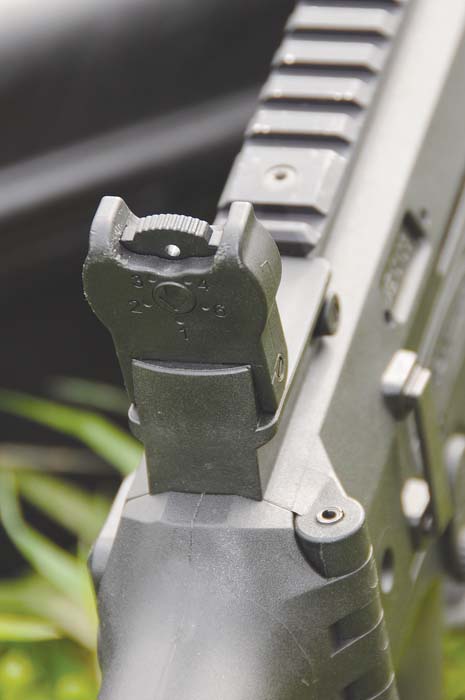
The gas block features a front sling swivel that is free to rotate 180 degrees allowing it to be out of the way when not needed, and a standard M7 bayonet lug, unorthodoxly positioned over, and on top of, the barrel.
The breech end of the barrel features a multi-lugged barrel extension, similar to the one used in the AR-15 family of weapons and of direct descent from Johnson’s system as used in his Model 1941 rifle. The barrel extension solves any headspace related problem and, being the only other part other than barrel, bolt and gas system subject to propellant gas pressure, allows the use of light materials such as polymers for the receiver of the weapon.
The bolt uses seven locking lugs, each radially placed at 40 degrees and two extractors are located respectively at 3 and 9 o’clock of the bolt face. Apparently, there is no ejector. Each extractor is spring loaded and has a small actuating rod that rides within, and extends beyond the rear of the bolt. Depending on how we move a steel block, accessed thru a hole in the rear of the receiver with the tip of a cartridge, an ejection side is selected. The receiver has an ejection port open on both sides and very shallow case deflectors are present just behind each ejection port. They work surprisingly well and the spent round is ejected towards the front with a 45 degree angle from the barrel.
When the bolt unlocks, and starts moving toward the back, the spent case rim is captured by both extractors. Approaching the end of the bolt’s travel, one of the two actuating rods of the extractor assembly hits the steel block and stops, while the bolt and the other extractor assembly keep moving rearwards. The case is violently pushed by the extractor that suddenly stopped, and that now acts as an ejector. The thrust is exerted not on the base of the cartridge but inside the extractor groove, on the chamfered portion of the groove, to be precise.
The bolt itself is a rather complex block of CNC machined forged steel. The body of the bolt is deeply fluted. The grooves serve as cam guides to rotate the bolt, thru an integral pin within the bolt carrier, to actuate locking and unlocking and also to prevent carbon and other grime build up. The firing pin is spring loaded. The bolt rear presents a milled slot where the firing pin head is located. If the bolt is not fully locked, and this slot is not perfectly vertical and aligned with the hammer, the latter cannot reach the firing pin head and even partial out-of-battery firing is totally prevented.
The bolt carrier is quite interesting as well. It is very long and the flat, strip shaped, front portion acts as an operating rod and receives the impulse from the gas cylinder. The upper portion of the carrier presents a milled channel that contains the recoil spring and guide, while the rear portion interfaces with the bolt. The vertical sides of the bolt carrier are flat and smooth. When the bolt is locked, the carrier seals both ejection ports – meaning a port cover is not needed. Between the bolt and the bolt carrier, right behind the bolt head, we find the hinged, small cocking handle and its flat spring. The cocking handle can be positioned indifferently to the left or to the right side of the weapon, depending on the operator’s choice.
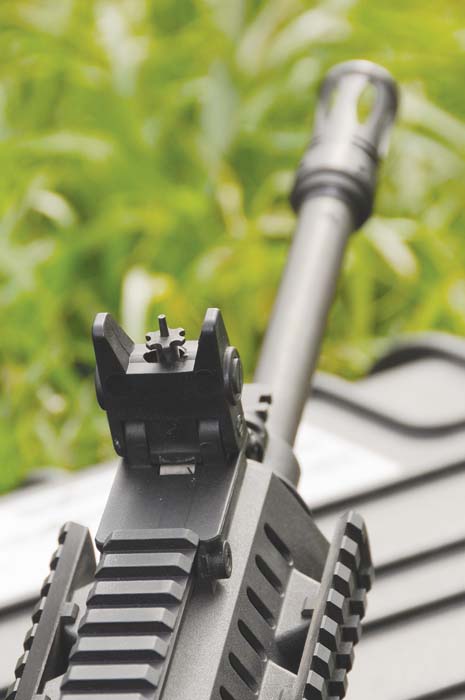
The weapon’s body is entirely made of an impact resistant Technopolymer plastic charged with composite fibers, and can be divided in two main assemblies. The upper receiver contains the bolt carrier group, barrel and gas system, and includes the integral handguard and ends with a folding, and partially collapsible, stock. The smaller lower receiver houses the trigger pack, the magazine well and pistol grip. The upper and lower receivers very cleverly interlock with each other when assembled together, and there is no need for receiver push-pins.
With the stock folded to the side of the weapon, we can access the disassembly lever. Pushing on the lever, and rotating the selector past the “safety” mark, we can pivot open the lower, and remove the bolt carrier assembly. We’ll also find that there is no “hinge,” simply a massive curved notch right in front of the magazine well.
The stock of the weapon is obviously in-line with the barrel, and it is permanently fastened to the upper receiver with a hinge on the right side while the latch button is on the left.
The injection molded upper receiver contains many metal parts and embedded subframes, such as structural reinforcements, sling loops, and metal backplates where Picatinny rails are bolted on. There are no metal guides for the bolt carrier, which rides in the receiver with metal to polymer contact only.
The smooth and streamlined appearance is not only due to “Italian Styling,” it also serves a purpose. Learning from other Polymer based weapon body designs Beretta engineered the weapon with constant curves to eliminate stress points which could lead to cracks.
The top of the upper receiver is fitted with one continuous 7075 alloy Picatinny rail. At the front of the fore-end, right behind the gas block, on both sides we find a number of cooling slots and two more small Picatinny rails, plus one more full length rail is present at the bottom. The latter is not fully 1913 standard, as it ends with a “T rail” specific for fastening the single shot GLX 160 40mm grenade launcher, and is normally protected with a plastic cover when no accessories (i.e. GLX160, VFG, or tactical flashlight) are mounted.
Foldable sights are standard issue. Made of the same polymer as the receivers, the sights are adjustable. The front sight post is adjustable in windage and elevation and the rear peep sight has a six pre-set position disc with dialed distances from 100 to 600 meters.
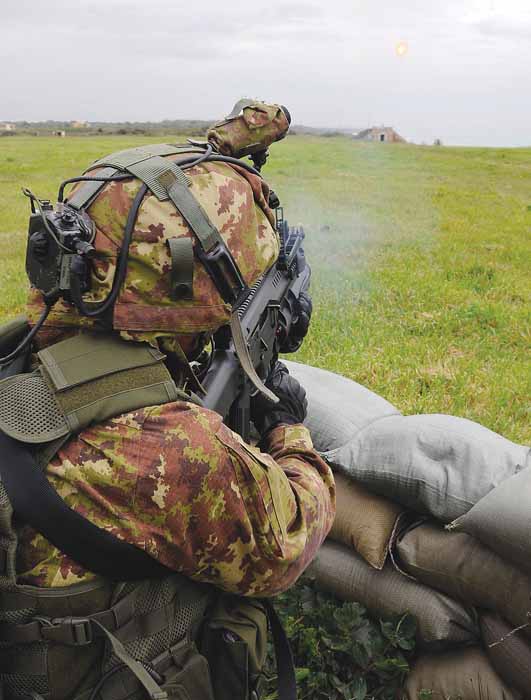
The sights mainly serve as BUIS, as Italy will field the ARX 160 with an optical primary sighting system: the Aimpoint ACIES, a custom version of the M2 CCO. Being the ARX 160 is the weapon for Italy’s “Soldato Futuro” program (the equivalent of USA’s Land Warrior program); a host of hi-tech aiming systems (including NVG, Thermal, LLTV and Image Fusion technology) are also available, although in prototype form.
The weapon has six sling loops: two on each side, one on the stock, and one on the gas block.
As mentioned, the cocking lever can be positioned on either side of the weapon. About in the middle of the ejection port there is a small mark molded in the plastic. Aligning the cocking lever with the mark, and pulling out the lever, the bolt carrier group freezes in place, and it is now possible to rotate the cocking lever from one side to the other, pushing it thru the ejection port. Pushing in the lever unlocks the bolt carrier and locks the new cocking lever position.
Looking at the aft portion of the upper receiver, next to the folding stock hinge, we note a large hole: it is also present on the other side of the receiver, next to the stock latch button. This is where we insert the tip of a cartridge to select the spent case ejection side.
The polymer stock with a rubber buttplate resembles a large, inverted “L” and is composed of two parts that can slide one inside the other. It is hinged to the receiver, and when folded (pressing on a latch similar in function to the one used in the SIG 550) it does not interfere with the controls or the ejection port, so the weapon remains fully useable. The length of the stock can be adjusted by collapsing the buttstock in one of 4 positions spanning 80 mm. The buttstock can also be completely removed revealing a small tubular compartment for batteries or cleaning kits.
The magazine well, in the lower receiver, is very peculiar. To release the magazine, the ARX 160 offers an ambidextrous and fenced button (similar to the one used in the AR 70/90) on each side of the receiver, and an additional button in the base of the trigger guard. Pushing right up with the thumb releases the magazine. This button is also fenced to prevent unwanted activation. The same button is also the hold open. When the bolt carrier group locks back on an empty magazine, the button will project inside the trigger guard, and upon magazine change, pressing down with the index finger on the button will release the bolt. It is actually a lot easier done than said.
The magazine is totally compatible with the universal STANAG 4179 standard (M16 magazines), and holds 30 rounds.
The fire control group is a classic internal hammer single action, selective fire design offering a three position selector lever, with safe (marked S), semiautomatic fire (1) and full auto (R). The lever itself is ambidextrous and of rounded, smooth design, rotating in total only 82 degrees for best comfort.
The pistol grip is of very simple design with a comfortable inclination and a moderate grip. It integrates a small compartment, closed with a trapdoor, for the issue cleaning kit.
Future improvements include the possibility to change calibers, swapping barrel, bolt, lower receiver and magazine. It is still some 70% of the gun, and it may be viable only for some agency large-scale inventory scenario, since the serial number is engraved on the upper receiver on a steel block embedded in the polymer and readable thru a small window on the right rear portion of the receiver. In addition to 5.56×45 NATO, Beretta has announced that the ARX 160 may be also available in 7.62×39 and 6.8×43 (6.8 SPC Remington). Feasibility studies of chambering the weapon in 5.45×39 mm (M74 Russian cartridge) are under way. Last but not least, a “Heavy” version is undergoing prototypal stages, chambered in 7.62×51 NATO, as this seems to be the trend in the industry and the market (M16 and SR25, SCAR L and H, HK 416 and 417).
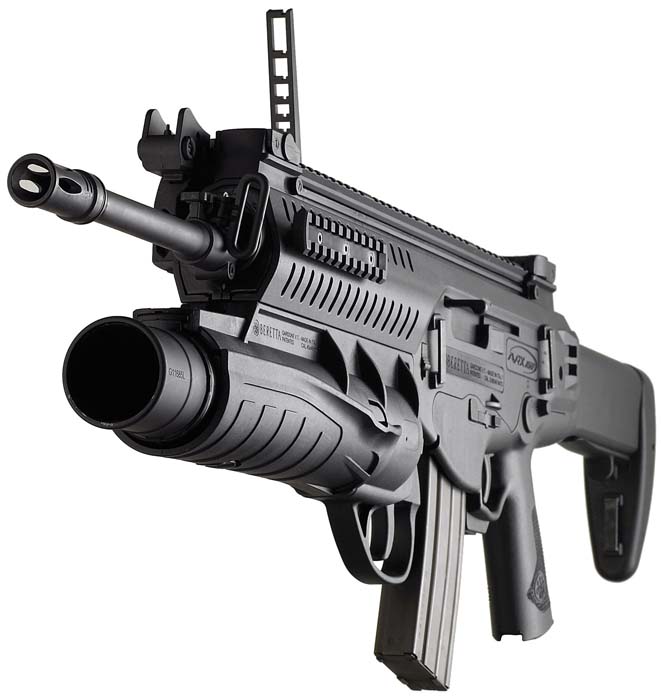
The weapon is well balanced though just a bit muzzle heavy. Once we adjusted the stock, cheek weld was perfect. Aiming using both optical sights and the provided fixed sights is natural and comfortable. Trigger reach is satisfactory for small and medium hands though it may be a bit short for operators with very large hands. The plastic trigger shoe is wide and smooth. Feedback is good both in aimed, accurate fire and in full auto. Controls are easy to reach with the firing hand’s index finger and thumb without having to change position.
On a tactical magazine change, the weapon offers various methods to release the bolt. Pulling on the cocking lever, pressing the hold open button inside the trigger guard, and slamming the rifle on the shoulder (works real good if you wear SAPI plates) as the bolt will move back a fraction of an inch and the bolt catch will disengage.
Rapidly shouldering the rifle from a low standby to the natural aiming point is fast and comfortable. The sight picture is perfect after a single familiarization session.
The trigger is smooth and predictable, and has a very crisp let off with minimal overtravel.
At this time, the ARX 160 has been thoroughly tested only in an Italian military proving ground. Reports credit the weapon with performance and MTBF comparable to the HK G36. Design and engineering of the weapon was refined following advice and feedback coming from actual users, serving in the various branches of the military that will most likely adopt the new ARX system as standard issue in the near future.
Samples have been sent abroad and a few are present in United States now for testing and evaluation.
The ARX 160 is a very flexible and innovative assault rifle, featuring many surprisingly simple and intelligent engineering solutions that allow the weapon to be easily adapted for the job. Maintenance of the system appears to be quite straightforward, and the manufacturer claims the weapon to be able to function even without lubrication. As for all things, time will tell if the ARX 160 will be a milestone in firearms development. Our impression is that Beretta managed to jump ahead with what, for all accounts, is a new generation of military assault rifles.
Manufacturer: Fabbrica D’Armi Pietro Beretta S.p.A. Gardone Val Trompia (BS); www.beretta.it
Model: ARX 160
Type: Modular, selective fire assault rifle
Rate of fire: 700 rounds per minute
Caliber: 5.56 x45 NATO
Action: Rotating, multi lug bolt, gas operated by a low pressure “short” stroke piston
Barrel: Chrome lined, 6 RH grooves, 1:7 twist; available lengths: 12 in. (305 mm) and 16 in. (406 mm)
Magazine: STANAG 4179, capacity: 30 rounds
FCG: Internal hammer single action, selective fire (semiautomatic and full auto). Closed bolt design.
Sights: Adjustable, folding iron sights; Picatinny 1913 rail for optical sight attachment
Materials: Barrel, bolt and carrier: forged steel; receivers and stock in technopolymer injection molded plastic charged with composite fibers, and embedded steel structure; Picatinny rails in 7075 alloy (Ergal)
Overall length: With a 16 in. barrel: 920 mm with stock extended; 820 mm stock fully collapsed and 690 mm with the stock folded on the side
| This article first appeared in Small Arms Review V13N9 (June 2010) |











